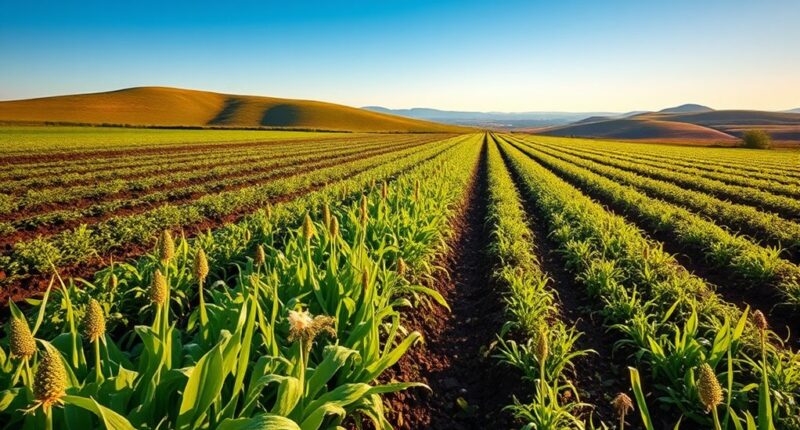Regenerative agriculture shows promise as a natural way to fight climate change by restoring soil health and increasing its capacity to lock in carbon. By adopting practices like cover cropping, reduced tillage, and diverse plantings, you help rebuild the soil’s ecosystem and improve water retention. These techniques also prevent land degradation and boost biodiversity, making farms more resilient to extreme weather. If you want to see how these methods transform land into a powerful climate solution, there’s more to discover.
Key Takeaways
- Regenerative agriculture rebuilds soil health, increasing carbon sequestration and reducing greenhouse gases.
- Practices like cover cropping and reduced tillage enhance soil microbial diversity and resilience.
- Healthy soils store more water, mitigate drought impacts, and prevent erosion, supporting climate adaptation.
- Diverse plant root systems promote soil vitality and help break pest cycles, reducing chemical dependencies.
- By transforming land into carbon sinks, regenerative farming directly combats climate change.

Have you ever wondered how farming can heal the land instead of deplete it? The answer lies in regenerative agriculture, a farming approach that focuses on restoring soil health and promoting biodiversity. When you adopt regenerative practices, you’re not just growing food—you’re nurturing the very foundation of your farm: the soil. Healthy soil isn’t just about fertile dirt; it’s a living ecosystem teeming with microbes, fungi, and organic matter that work together to lock in carbon, improve water retention, and support plant growth. By prioritizing soil health, you help create a resilient environment that can withstand droughts, floods, and other climate challenges. This process begins with understanding how traditional farming methods often strip away soil nutrients and organic matter, leaving land vulnerable and less productive over time. In contrast, regenerative techniques like cover cropping, reduced tillage, and composting actively rebuild this essential ecosystem. Additionally, fostering soil microbial diversity enhances nutrient cycling and promotes a more resilient soil environment. Crop diversity plays an equally pivotal role in this healing process. Instead of planting monocultures, where a single crop dominates large swaths of land, you diversify your plantings. This not only prevents soil exhaustion but also reduces pest and disease pressures naturally. When you grow a variety of crops—cover crops, legumes, grains, and vegetables—you create a more complex root system that benefits soil structure and microbial life. Diverse plant roots exude different nutrients, feeding soil organisms and encouraging a healthy, balanced ecosystem underground. These crops help break pest cycles, improve nutrient cycling, and prevent soil erosion. The more varied your plantings, the more resilient your soil becomes, capable of bouncing back from adverse weather and human disturbances. Implementing crop diversity alongside soil health practices turns your farm into a regenerative system. You’re not just growing food; you’re building a living, breathing landscape that sequesters carbon from the atmosphere and reduces greenhouse gases. This approach creates a positive feedback loop: healthier soil supports more diverse crops, which further enhances soil vitality. As you embrace these methods, you transform your land into a carbon sink rather than a source of emissions. It’s a powerful shift that can help combat climate change while improving farm productivity. The beauty of regenerative agriculture is that it aligns economic benefits with environmental healing. By focusing on soil health and crop diversity, you can foster a sustainable future—one where farming heals rather than harms the planet.
Frequently Asked Questions
How Quickly Can Regenerative Agriculture Impact Climate Change?
You can see climate change impacts shift relatively quickly through regenerative agriculture, often within a few years. By increasing microbial diversity in soils, you enhance carbon sequestration, which traps more greenhouse gases. As you adopt practices like cover cropping and reduced tillage, you help soils become healthier and more resilient, leading to faster carbon storage. This active approach accelerates climate benefits, making a tangible difference in just a few seasons.
What Are the Costs Associated With Transitioning to Regenerative Practices?
You might face costs when shifting to regenerative practices, including investing in new equipment and training. Economic incentives can help offset these expenses, making the shift more feasible. However, policy barriers, like lack of supportive regulations or subsidies, could slow your progress. While initial costs can be significant, the long-term benefits—improved soil health and climate resilience—often outweigh these challenges, encouraging you to push forward.
Are There Any Drawbacks or Risks to Regenerative Agriculture?
You might wonder if regenerative agriculture has drawbacks or risks. While it offers benefits, you should also consider potential soil contamination if practices aren’t well-managed, and water management challenges that can arise from changing traditional methods. These risks require careful planning, ongoing monitoring, and adaptation. By addressing potential soil contamination and water issues proactively, you can minimize risks and maximize the positive impacts of regenerative farming.
How Scalable Is Regenerative Agriculture for Large Industrial Farms?
You might wonder about the scalability challenges of regenerative agriculture for large industrial farms. While it’s promising, adapting these methods on a broad scale requires significant changes in practices, infrastructure, and mindset. Industrial adaptation can be complex, but with proper support and innovation, you can overcome barriers. Large farms can adopt regenerative techniques gradually, making them more sustainable while maintaining productivity and addressing climate change impacts effectively.
Can Regenerative Agriculture Improve Soil Health in Arid Regions?
You might wonder if regenerative agriculture can truly improve soil health in arid regions. The answer is yes, especially when you incorporate desert reforestation and water conservation techniques. These methods help restore soil structure, boost moisture retention, and promote plant growth. By focusing on native plants and efficient water use, you can turn barren landscapes into productive, resilient ecosystems, making a positive impact despite the challenging climate conditions.
Conclusion
As you embrace regenerative agriculture, remember it’s like planting the seeds of a new dawn—one where the soil heals itself, much like the phoenix rising from ashes. By nurturing the land, you become part of a story greater than yourself, turning the tides against climate change. This isn’t just about farming; it’s about rewriting the future, one healthy soil at a time. Together, you can ignite the hope that sparks a sustainable tomorrow.










